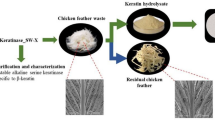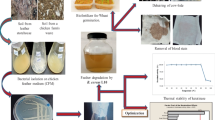Abstract
In this study thermostable keratinase rK27 of Bacillus pumilus KS12 was expressed and secreted in Bacillus subtilis WB980 expression system under the control of xylose promoter (PxylA). The concentration of the recombinant keratinase rK27 produced by B. subtilis reached 4,432 U/mL after 24 h of culture at 37 °C and 200 rpm with 0.5 % xylose at an initial concentration of 0.3 OD600nm. Using the one-factor-at-a-time approach, we achieved an improvement in enzyme yield of up to 3.4-fold (15,390 U/mL) in the presence of 3 % yeast extract and 0.5 % tryptone. The enzyme was purified to homogenity using nickel affinity chromatography with a 3.63-fold purity and 80 % recovery. The purified enzyme rK27 hydrolyzed 1 g bone meal after 12 h at 40 °C, pH 9, with a maximum protein release of 37.3 mg/g bone meal; in comparison subtilisin Carlsberg hydrolyzed 19.3 mg/g bone meal and proteinase K hydrolyzed 6.2 mg/g bone meal. The hydrolysate obtained after hydrolysis of bone by rK27 was found to be effective as a flocculant at 0.1 mg in a 10 % (w/v) kaolin solution when compared with hydrolysates obtained from substilisin Carlsberg and proteinase K, which were effective at 0.5 mg and >2 mg, respectively.






Similar content being viewed by others
References
Bradford MM (1976) A rapid and sensitive method for the quantization of microgram quantities of protein utilizing the principle of protein-dye binding. Anal Biochem 72:248–254
Brandelli A (2008) Bacterial keratinases: useful enzymes for bioprocessing agroindustrial wastes and beyond. Food Bioprocess Technol 1:105–116
Brandelli A, Daroit DJ, Riffel A (2010) Biochemical features of microbial keratinases and their production and applications. Appl Microbiol Biotechnol 85:1735–1750
Chu IM, Lee C, Li TS (1992) Production and degradation of alkaline protease in batch cultures of Bacillus subtilis ATCC 14416. Enzyme Microb Technol 14:755–761
Garcia RA, Rosentrater KA, Flores RA (2006) Characteristics of North American meat and bone meal relevant to the development of non-feed applications. Appl Eng Agric 22:729–736
Jang JW, Jun HK, Kim EK, Jang WH, Kang JH, Yoo OJ (2001) Enhanced thermal stability of an alkaline protease, AprP, isolated from a Pseudomonas sp. by mutation at an atuproteolysis site, Ser-331. Biotechnol Appl Biochem 34:81–94
Li W, Zhou X, Lu P (2004) Bottlenecks in the expression and secretion of heterologous proteins in Bacillus subtilis. Res Microbiol 155:605–610
Lin X, Wong SL, Miller ES, Shih JC (1997) Expression of the Bacillus licheniformis PWD-1 keratinase gene in Bacillus subtilis. J Ind Microbiol Biotechnol 19:134–138
Lin HH, Yin LJ, Jiang ST (2009) Expression and purification of Pseudomonas aeruginosa keratinase in Bacillus subtilis DB104 expression system. J Agric Food Chem 57:7779–7784
Liu B, Zhang J, Xiangru-Liao BL, Du G, Chen J (2012) Expression and characterization of extreme alkaline, oxidation-resistant keratinase from Bacillus licheniformis in recombinant Bacillus subtilis WB600 expression system and its application in wool fiber processing. World J Microbiol Biotechnol 29:825–832
Maximova N, Dahl O (2006) Environmental implications of aggregation phenomena: current understanding. Curr Opin Colloid Interface Sci 11:246–266
Nasser MS, James AE (2007) Effect of polyacrylamide polymers on floc size and rheological behaviour of kaolinite suspensions. Colloids Surf, A 301:311–322
Ohlsson BG, Westrom BR, Karlsson BW (1986) Enzymoblotting: a method for localizing proteinases and their zymogens using para-nitroanilide substrates after agarose gel electrophoresis and transfer to nitrocellulose. Anal Biochem 152:239–244
Palmen TG, Scheidle M, Huber R, Kamerke C, Wilming A, Dittrich B, Klee D, Buchs J (2013) Influence of initial pH values on the lag phase of Escherichia coli and Bacillus licheniformis batch cultures. Chem Eng Technol. doi:10.1002/cite.201200200
Pan J, Huang Q, Zhang Y (2004) Gene cloning and expression of an alkaline serine protease with dehairing function from Bacillus pumilus. Curr Microbiol 49:165–169
Park SK, Bae DH, Hettiarachchy NS (2000) Protein concentrate and adhesives from meat and bone meal. J Am Oil Chem Soc 77:1223–1227
Piazza GJ, Garcia RA (2010a) Meat and bone meal extract and gelatin as renewable flocculants. Bioresour Technol 101:781–787
Piazza GJ, Garcia RA (2010b) Proteins and peptides as renewable flocculants. Bioresour Technol 101:5759–5766
Piazza GJ, Garcia RA (2013) Proteolysis of meat and bone meal to increase utilisation. Anim Prod Sci. doi:10.1071/AN13041
Piazza GJ, McAloon AJ, Garcia RA (2011) A renewable flocculant from a poultry slaughterhouse waste and preliminary estimate of production costs. Resour Conserv Recy 55:842–848
Radha S, Gunasekaran P (2007) Cloning and expression of keratinase gene in Bacillus megaterium and optimization of fermentation conditions for the production of keratinase by recombinant strain. J Appl Microbiol 103:1301–1310
Rajput R, Gupta R (2012) Enhanced production of recombinant thermostable keratinase of Bacillus pumilus KS12: Degradation of Sup35NM. Res J Microbiol 6:839–850
Rajput R, Gupta R (2013) Thermostable keratinase from Bacillus pumilus KS12: Production, chitin crosslinking and degradation of Sup35NM aggregates. Bioresour Technol 133:118–126
Rajput R, Sharma R, Gupta R (2011) Cloning and characterization of a thermostable, detergent-compatible recombinant keratinase from Bacillus pumilus KS12. Biotechnol Appl Biochem 58:109–118
Suzuki Y, Tsujimoto Y, Matsui H, Watanabe K (2006) Decomposition of extremely hard-to-degrade animal proteins by thermophilic bacteria. J Biosci Bioeng 102:73–81
Terpe K (2006) Overview of bacterial expression systems for heterologous protein production: from molecular and biochemical fundamentals to commercial systems. Appl Microbiol Biotechnol 72:211–222
Wang JJ, Shih JCH (1999) Fermentation production of keratinase from Bacillus licheniformis PWD-1 and a recombinant Bacillus subtilis FDB-29. J Ind Microbiol Biotechnol 22:608–616
Wang JJ, Rojanatavorn K, Shih JCH (2004) Increased production of Bacillus keratinase by chromosomal integration of multiple copies of the kerA gene. Biotechnol Bioeng 87:459–464
Westers L, Westers H, Quax WJ (2004) Bacillus subtilis as cell factory for pharmaceutical proteins: a biotechnological approach to optimize the host organism. Biochim Biophys Acta 1694:299–310
Wu G, Healy MG, Zhan X (2009) Effect of the solid content on anaerobic digestion of meat and bone meal. Bioresour Technol 100:4326–4331
Yang Y, Biedendieck R, Wang W, Gamer M, Malten M, Jahn D (2006) High yield recombinant Penicillin G amidase production and export into the growth medium using Bacillus megaterium. Microb Cell Fact 5:36
Zaghloul TI (1998) Cloned Bacillus subtilis alkaline protease (aprA) gene showing high level of keratinolytic activity. Appl Biochem Bioetchnol 72:199–205
Acknowledgments
Financial assistance from University of Delhi, Misc. R & D Grant and Department of Biotechnology, New Delhi through project no. BT/PR012505/PID/06/01/2009 is duly acknowledged.
Author information
Authors and Affiliations
Corresponding author
Rights and permissions
About this article
Cite this article
Rajput, R., Gupta, R. Expression of Bacillus pumilus keratinase rK27 in Bacillus subtilis: enzyme application for developing renewable flocculants from bone meal. Ann Microbiol 64, 1257–1266 (2014). https://doi.org/10.1007/s13213-013-0770-2
Received:
Accepted:
Published:
Issue Date:
DOI: https://doi.org/10.1007/s13213-013-0770-2




